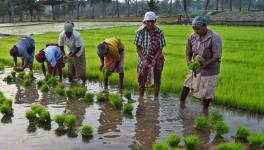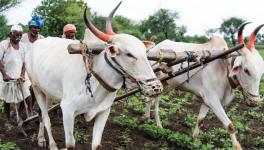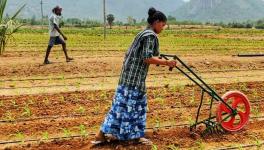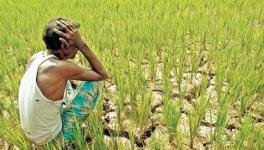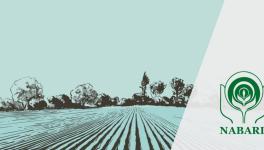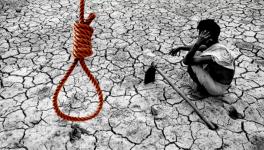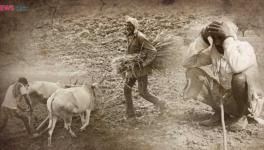Women Are Single Largest Exclusion in India's Farmer Suicides Data: Sainath

Image Courtesy: PTI
New Delhi: Tens of thousands of women get excluded from the farmer suicides data in the country just because they are never considered as farmers, senior journalist-cum-agriculture expert P Sainath said on Friday.
Delivering his valedictorian address at the XVI National Conference of Indian Association for Women's Studies (IAWS) here, Sainath, 63, said climate change was going to affect women more as they are the providers of water, food, fodder and fuels.
Statistics for female farmer suicides are "complete rubbish" as the discussion on women victims of agrarian crisis often becomes a discussion of their role as widows of male farmers, he said.
"Those women are farmers themselves and even before the males committed suicides they were doing 60% of the work on the farm. They are the lead farmers on that household. Maharashtra is full of this.
"We correctly focus on the invisibility of women in the statistical systems, all that is true, but apart from invisibility there is something hiding in plain sight which is what happens with women farmers and women farmers' suicides," Sainath said.
Taking a pot-shot at the National Crime Records Bureau (NCRB), the journalist called it a "paradise for women farmers" as women farmers' suicides was the only category in the country where many states show zero incidences every year.
The NCRB is an Indian government agency responsible for collecting and analysing crime data as defined by the Indian Penal Code and special and local laws.
"Punjab and Haryana are the seventh heaven. You don't have women farmer suicides because you don't recognise them as farmers. By the way, statistically, it is impossible that a state with lakhs of women farmers shows zero women farmer suicides. Where do they hide the corpses," Sainath quipped.
He asserted that women farmers coming from the landed families often end up in the catch-all-categories column of 'housewives'.
"Many girls and women have been pushed into the column of housewives. That is the easiest category to throw a woman in data collection. It is not only a problem of how we categorise work but also the victims have accepted it. In Tamil Nadu, you ask a woman who works 16 hours a day 'what do you do' and she says 'I sit at home'. That perception has taken the grip of the victims' mind also that what we do is not work. Whereas, the landless farmers, I guess, are going into 'others'," he said.
Sainath said though he uses the NCRB data, it has become "unusable" in the last three years. Post 2014, the sins of omission have been joined by the sins of commission, he added.
"It's not just prejudices at the time of data collection, there are huge imposed frauds in the methodology from Delhi. The NCRB data was the best we had on farmers suicides. The prejudices that came into the data were societal and not the basis of the NCRB. That was the prejudice of the constable at the village level. There are eight exclusions from the data but the three largest are - women farmers, Dalit farmers and Adivasi farmers.
"Adivasis are called encroachers on forest land. The concept of patta (legal document issued by the government in the name of the actual owner of a particular plot of land) simply doesn't arise. With Dalit farmers, you have an amazing system for more than 30-40 years. Large groups of farmers who have land but no patta and large groups of Dalit farmers who have pattas but no land. Bihar is full of that," Sainath said.
Women cut across all three categories. They are the "single largest exclusion" in the farmer suicides data, he added.
"The police don't read the Census manual. They follow the DSP's oral instruction. That's how tens of thousands of women get excluded simply because they are never going to be called farmers," Sainath said.
He said there is a "simple good old male reason" why three-four states see a rise in the number of women cultivators.
"It's astonishing. Many states have the provision but 3-4 states in 2005-10, including Maharashtra, launched a drive to get women's names put on the patta. So they incentivised this by offering one-third discount if a woman's name is put on the patta. Overnight, lakhs of men put names of women of their households on pattas and made them landowners but these women did not even know about it," Sainath added.
Unless the whole idea of unpaid work is challenged, these troubles are going to continue, the founder editor of the People's Archive of Rural India (PARI) said.
According to Oxfam's annual inequality report, women and girls across the world each and every day of every single year produce 12.5 billion hours of unpaid work.
"It is $10.8 trillion annually - that is five times India's GDP. It's more than three times the size of the global tech industry which includes Microsoft, Apple, Amazon and the works. Figures quoted by the UNDP and the IPCC suggest that 80 per cent of people displaced by the climate crisis are women. They are all the more vulnerable due to non-climatic factors. The UNDP also said that 70 per cent of the people worst affected by the 2004 Tsunami were women and children," Sainath said.
He added that in its research, PARI found many women-led occupations that are devastated by global warming.
"In coastal areas you have women seaweed harvesters. These women are telling you in simpler words what scientists tell you in 800 pages that the seas are getting rougher, warmer and the levels are rising. Their job is getting tougher," the veteran journalist said.
Climate crisis and global warming need to be taken "very seriously", he added.
"These stories need to be told from the lived experience of ordinary people, using scientists and experts to back them up and articulate what they are saying in a better manner. The average rural Indian has a much better appreciation of the different meanings of temperature, weather and climate than we do. They understand that these are different categories, we use them interchangeably," Sainath said.
Get the latest reports & analysis with people's perspective on Protests, movements & deep analytical videos, discussions of the current affairs in your Telegram app. Subscribe to NewsClick's Telegram channel & get Real-Time updates on stories, as they get published on our website.










